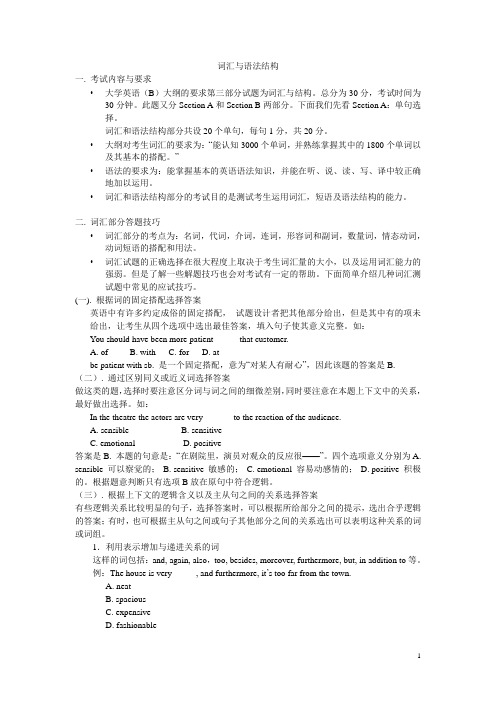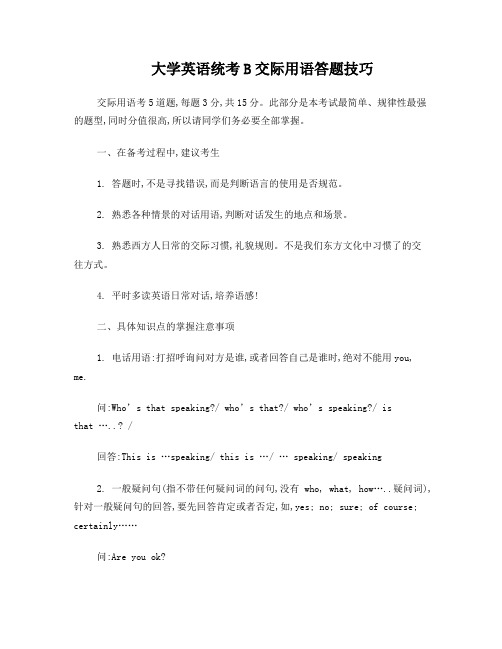大学英语统考B词汇与语法结构答题技巧
统考大学英语B考试技巧 精品

本次考试采用全新的2010年新版大纲,考试题型和内容跟以往均有所不同,考试题型和分值为下图所示:模拟题由原先的大学英语(B)模拟试卷6套(2007年修订版)改为大学英语(B)模拟试卷9套(2010年修订版),题目的范围及重点发生了一些变化,相对来说难度下调,1.交际英语,5题15分,此部分与以前没有太多变化,更加注重测试考生在日常生活情景中的交际能力,单词较简单,将此部分题库熟读几次,将可以拿到15分满分。
2.阅读理解,2篇短文,满分30分。
第一篇短文改为正误判断题,投机几率加大,较易得分。
一般是根据文章的事实或细节,给出一个句子,判断其正误。
比较直接,难度相对较小。
做此类题时,应先看题,后带着―问题‖快速阅读短文,寻找所需要的信息. 第二篇短文为2010年9套模拟题中的18篇阅读理解中选择一篇,15分等于白送,此部分完全可以拿到20分以上。
3.词汇与结构,5题10分,新版大纲降低了此部分的分值,对于基础较差的同学来说是个好事,此部分突击起来有一定难度,如果基础不是很好,可以重点看一些题目即可,拿下2题就可以了,此部分预计分数4分。
4.完形填空,1篇短文,5空10分,新版大纲在完形填空上的改变较大,难度降低显而易见,5个单词填入5个的空白处,通过逻辑推理等方法或投机方法也可以对上1-2个5.英译汉,4题20分,新版大纲增加了此部分的分值,对于基础较差的同学又是一件好事,题库中基本包含了全部的考试题目,大家可以经常看看,熟悉英文的单词,然后记下汉语意思,考试的时候只要大概意思对上即可,所以此部分拿分要在15分以上。
6.写作,1题15分,此部分没有太大改变,大家有基础复习一些范文或是用WORD写点都没有太大问题,拿5分没有难度。
综上所述,2010年薪的考试大纲难度降低,只要进行一定的温习即可获得及格的分数。
能将资料用光盘或U盘带进考场拷入电脑最好,首推用光盘,不用弯腰,相对来说光盘限制的可能性小的多。
大学英语B级等级考试词汇用法和语法结构解题技巧-最新教育资料

大学英语B级等级考试词汇用法和语法结构解题技巧根据高等学校英语应用能力B级考试大纲,词汇用法和语法结构为英语B级考试的第二部分,考试时间15分钟,题型为SectionA的选择题和SectionB的填空题。
选择题10题占据5分,填空题10题占据10分。
从历年来的学生反馈,选择题所涉及的语法结构及词汇用法一般得分在2-3分,而词性转换部分平均得分4-5分。
该部分所涉及的语言点较广及词的变化形式较灵活,学生的基础知识若不够扎实将失分严重。
以下将以历年的真题为例,分别对选择题和填空题的解题技巧进行分析与总结。
一、针对选择题的题型分析在历年的真题考试中,第二部分的选择题有着比较固定的出题方向。
1单词、词组的辨析关于对单词及词组的辨析的考核一般在选择题的题数中占据3到4题。
其中有动词辨析,名词辨析,形容词辨析以及代词的辨析。
该部分要求教师在平时的授课过程中严格要求学生掌握B级词汇的基本用法及意思并进行积累。
单词是学习语言的根本。
学生在平时的词汇积累过程中要学会反复自我测试,善于把简单的单词按照老师课堂所举的例子反复不断地运用到平时生活中,或者用自己的方法总结规律,只有这样才能牢记并掌握单词。
单从2012年6月的真题分析,其单词词组辨析就考了4题。
所以词汇的积累不容小觑。
例1:I'mpleasedtotellyouthatthefaxmachinesyouor-dered are_______now.(2012-6)A.availableB.convenientC.wonderfulD.important正确答案:A解析:本题为单词辨析,考查的是形容词的意思。
Avail-able意思是“可用的,可得到的”;convenient意思是“方便的”;wonderful意思“精彩的”;important意思是“重要的”。
根据题意“我很高兴告诉你,你订购的传真机到了”。
故选择A。
例2:Can you help me to_______a sales plan in thatarea?(2012-6)A.set upB.give inC.put onD.work out正确答案:D解析:本题考查为词组辨析,考查的是短语的意思。
词汇及语法结构

词汇与语法结构一. 考试内容与要求•大学英语(B)大纲的要求第三部分试题为词汇与结构。
总分为30分,考试时间为30分钟。
此题又分Section A和Section B两部分。
下面我们先看Section A:单句选择。
词汇和语法结构部分共设20个单句,每句1分,共20分。
•大纲对考生词汇的要求为:“能认知3000个单词,并熟练掌握其中的1800个单词以及其基本的搭配。
”•语法的要求为:能掌握基本的英语语法知识,并能在听、说、读、写、译中较正确地加以运用。
•词汇和语法结构部分的考试目的是测试考生运用词汇,短语及语法结构的能力。
二. 词汇部分答题技巧•词汇部分的考点为:名词,代词,介词,连词,形容词和副词,数量词,情态动词,动词短语的搭配和用法。
•词汇试题的正确选择在很大程度上取决于考生词汇量的大小,以及运用词汇能力的强弱。
但是了解一些解题技巧也会对考试有一定的帮助。
下面简单介绍几种词汇测试题中常见的应试技巧。
(一). 根据词的固定搭配选择答案英语中有许多约定成俗的固定搭配,试题设计者把其他部分给出,但是其中有的项未给出,让考生从四个选项中选出最佳答案,填入句子使其意义完整。
如:Y ou should have been more patient _____ that customer.A. ofB. withC. forD. atbe patient with sb. 是一个固定搭配,意为“对某人有耐心”,因此该题的答案是B. (二). 通过区别同义或近义词选择答案做这类的题,选择时要注意区分词与词之间的细微差别,同时要注意在本题上下文中的关系,最好做出选择。
如:In the theatre the actors are very ______ to the reaction of the audience.A. sensibleB. sensitiveC. emotionalD. positive答案是B. 本题的句意是:“在剧院里,演员对观众的反应很——”。
大学英语统考B交际用语答题技巧

大学英语统考B交际用语答题技巧交际用语考5道题,每题3分,共15分。
此部分是本考试最简单、规律性最强的题型,同时分值很高,所以请同学们务必要全部掌握。
一、在备考过程中,建议考生1. 答题时,不是寻找错误,而是判断语言的使用是否规范。
2. 熟悉各种情景的对话用语,判断对话发生的地点和场景。
3. 熟悉西方人日常的交际习惯,礼貌规则。
不是我们东方文化中习惯了的交往方式。
4. 平时多读英语日常对话,培养语感!二、具体知识点的掌握注意事项1. 电话用语:打招呼询问对方是谁,或者回答自己是谁时,绝对不能用you, me.问:Who’s that speaking?/ who’s that?/ who’s speaking?/ isthat …..? /回答:This is …speaking/ this is …/ … speaking/ speaking2. 一般疑问句(指不带任何疑问词的问句,没有who, what, how…..疑问词),针对一般疑问句的回答,要先回答肯定或者否定,如,yes; no; sure; of course; certai nly……问:Are you ok?回答: Yes, I am fine.3. 特殊疑问句(指带有疑问词的问句):针对特殊疑问句,回答时,要根据疑问词来进行回答,如when, how, what, who, why, which…问: When will you come?回答:At five o’ clock.4. 问候语“你好吗?”的几种表达和回答:问:How are you? How are you doing? How have you been? How’s everything with you?回答: Fine / great / not bad /5. 特殊句型:mind 引导的问句需要注意,介意时用yes回答,不介意用no回答。
问: Do you mind opening the door?回答: No, go ahead. / No, please.6. 回答问题时,句子的前后肯否定要保持一致。
英语B级考试词汇和语法结构应试技巧研究

英语B级考试词汇和语法结构应试技巧研究【摘要】高等学校英语应用能力考试是面向高等学校专科层次考生的标准化英语水平考试。
本文主要就B级考试中词汇和语法结构部分进行探讨。
通过统计真题试卷,总结要点、解析技巧,旨在帮助考生有效地提高应试技巧。
【关键词】英语B级考试;词汇和语法结构;应试技巧高等学校英语应用能力考试以《高职高专教育英语课程教学基本要求》为依据,注重考生英语的应用能力。
本文是对B级的词汇和语法结构部分进行研究。
一、题型特点词汇和语法结构主要测试考生运用词语和语法知识的能力。
题型有两种:Section A为单项选择;Section B为填空题。
二、学情分析高职学生普遍英语基础差,表现在词汇量少、语法由于没有将知识系统性理解及内化,应用能力差,面对考题往往束手无策,提高缓慢。
根据这种情况,深入地剖析考题,帮助考生有针对性地掌握高频出现的考点,运用恰当的解题方法显得尤为重要。
三、考点分析通过对2001年至2013年这13年以来的试题进行统计分析,发现高频率出现的考点有构词法(104次)、时态语态(99次)、非谓语动词(88次)、词义辨析(81次)、词语搭配(78次)、比较级和最高级(26次)、状语从句(20次)、定语从句(17次),偶尔会考到同位语从句、倒装句、强调句等。
四、考点详解以下就一些常考的知识点结合真题进行深入剖析。
(一)构词法从统计结果来看,构词法在填空题部分出现的比率最高。
因此,考生需要了解英语构词的一些常用技巧,特别是派生法,即在词根前加前缀或在词根后加后缀构成一个与原词意义相近或截然不同的新词,其中常考的为后缀,如名词后缀-ment、-tion/-sion、-ness,-er/ee等,形容词后缀-al、-ful、-y、-less、-ive、-ent 等,形容词变副词在词尾加ly,动词后缀-en等。
从历年考试来看,只要熟悉一些常用词就可以了,有些词反复出现,因而考生可以通过真题来复习。
【英语】大学英语B统考应试技巧

【关键字】英语交际用语这个部分是5个情景对话,目的是测试考生对交际英语的理解。
首先,考生要掌握常用的交际套语;另外,在答题时要特别注意用英语的思维方式来推理和判断。
为了做好这部分题,考生平时需要积累一些英语国家的文化、历史和人文等知识。
从应试的角度讲,应多做此类的习题。
提示:平时多读英语日常对话,培养语感!请大家掌握好以下常见口语表达,熟记它们的意思。
I see.我明白了。
Me too.我也是。
My God! 天哪!Come on.来吧(赶快)Hold on.等一等。
I agree. 我同意。
Not bad.还不错。
Not yet.还没。
See you.再见。
So long.再见。
Why not? 好呀! (为什么不呢?) Cheer up! 振作起来!Good job! 做得好!Have fun! 玩得开心!I’m full.Thanks. 我饱了,谢谢。
My treat.我请客。
So do I.我也一样。
This way. 这边请。
After you.您先。
Bless you! 祝福你!Follow me.跟我来。
Forget it! 休想! (算了!)Good luck! 祝好运!I promise.我保证。
Take care! 保重!Watch out! 当心。
What’s up? 有什么事吗?Be careful! 注意!Bottoms up! 干杯!Guess what? 猜猜看?I think so.我也这么想。
Let me see.让我想想。
No problem! 没问题! What’s new? 有什么新鲜事吗?Count me on. 算上我。
Don’t worry.别担心。
Do you feel better? 觉得好点了吗?Is it yours? 这是你的吗?That’s neat.这很好。
Are you sure? 你肯定吗?Here you are.给你。
Take it easy.别紧张。
英语b级解题技巧

英语b级解题技巧
以下是英语B级考试的解题技巧:
1. 听力部分:这部分主要考察考生对英语听说的理解和应用能力。
在备考过程中,考生需要多听英语原声材料,如英语新闻、英语歌曲等,同时还需要注意听力词汇的积累,加强对同义转换和短文理解的把握。
在听力开始前,应迅速浏览问题和选项,把握关键词和主题,有针对性地捕捉关键信息。
2. 阅读理解部分:这部分主要考察考生对英语文章的理解和信息提取能力。
在备考过程中,考生需要多读英语文章,提高阅读速度和理解能力。
同时,还需要掌握一些阅读技巧,如定位、推理判断、寻找中心句等。
在阅读时,应先看问题,再阅读文章,注意寻找关键词和主题句,理解文章的主旨和细节。
3. 翻译部分:这部分主要考察考生对英语和汉语之间的翻译能力。
在备考过程中,考生需要多进行英汉互译的训练,积累相关词汇和表达方式。
在翻译时,应注意语言的准确性和流畅性,把握原文的意思和风格。
4. 写作部分:这部分主要考察考生对英语写作的应用能力。
在备考过程中,考生需要多写英语作文,提高语言组织和表达能力。
同时,还需要注意写作的格式和规范,如段落结构、语法、拼写等。
在写作时,应先构思好主题和结构,注意语言表达的准确性和丰富性。
总的来说,备考英语B级考试需要注重基础知识的积累和应用能力的提升。
同时,还需要注意考试的要求和评分标准,有针对性地进行训练和提高。
英语b级语法、词组、单词集合

大学英语语法词汇词组集合大学英语B级统考之语法概要大学英语三级统考之语法部分主要涉及到连接词、动词形式与时态、主谓语一致、虚拟语气等内容,为方便考生对语法知识的复习,现将考试当中重点涉及的内容总结如下:(一)名词A.知识要点名词可分为可数名词和不可数名词。
可数名词有单、复数之分。
1.不可数名词只用单数形式。
如果要表示数量多少,需在其前面加量词来表达。
如:apieceofnews (一条新闻);twopiecesofadvice(两条建议)2.名词所有格的构成是名词加“’s”,如:Mary’sroom;如原词已有复数词尾-s,则只加“’”,如:thestudents’hall,通常用于有生命的存在物的名词;名词所有格也可以由介词of加名词构成,通常用于无生命的存在物的名词,如:thewindowoftheclassroom.B.例题讲解Whatabeautifulhouse!Especiallytherearemany______.A.furnitureB.furnituresC.piecesoffurnitureD.piecesoffurnitures 解析:此题考查名词的单复数。
Furniture为不可数名词,后面不能加s。
很多家具用manypiecesoffurniture,因此答案为C。
(二)冠词A.知识要点冠词是一种虚词,用在名词前面,说明名词是特指还是泛指。
冠词分不定冠词和定冠词。
1.不定冠词:a/an表示“一”、“某一”概念,用于单数可数名词前。
a用在辅音开头的词前,an 用在元音开头的词前。
如:anEnglishteacher/asecondyear一位老师/又一年;2.定冠词:the表示“特指的一个或一些”。
通常用在形容词最高级及序数词前,或世界上独一无二的事物前;也用于乐器名词前。
如:thebestseason最好的季节/thefirstlady第一夫人/theearth地球/playthepiano弹钢琴;3.不使用冠词的情况:在三餐饭、球类运动和娱乐活动的名称之前。
- 1、下载文档前请自行甄别文档内容的完整性,平台不提供额外的编辑、内容补充、找答案等附加服务。
- 2、"仅部分预览"的文档,不可在线预览部分如存在完整性等问题,可反馈申请退款(可完整预览的文档不适用该条件!)。
- 3、如文档侵犯您的权益,请联系客服反馈,我们会尽快为您处理(人工客服工作时间:9:00-18:30)。
大学英语统考 B 词汇与语法结构答题技巧大学英语(B)大纲的要求第三部分试题为词汇与结构。
总分为10 分,考试时间为10 分钟。
(一)词汇部分考试重点:名词,代词,介词,连词,形容词和副词,动词短语的搭配和用法。
词汇试题的正确选择在很大程度上取决于考生词汇量的大小,以及运用词汇能力的强弱。
但是了解一些解题技巧也会对考试有一定的帮助。
下面简单介绍几种词汇测试题中常见的应试技巧。
1.利用表示增加与递进关系的词这样的词包括:and, again, also,too, besides, moreover, furthermore, but, in addition to 等。
2.利用表示比较与对比关系的词这样的词包括:but, however, although, in contrast, instead of 等。
3.利用表示因果关系的词这样的词包括:because ,so, as a result, thus, consequently, therefore 等。
4.利用表示让步关系的词这类词包括:if, although, in spite of, while, whereas 等。
5.根据词法常识判断选择有些词汇测试题,从词的意义去考虑,填入多个选择项都可以。
在这种情况下,如果借助语法结构对题目进行分析,往往可以找到正确答案。
6.排除法在做词汇题时,常会遇到一时难以判断哪一个是正确答案的情况。
这时不妨从不符合题义的选项着手,将非正确答案逐一排除,剩下的多半就是正确答案。
此方法同样适用阅读理解,语法及完形填空部分的试题,在此不再一一举例。
(二)语法重点语法部分主要涵盖以下重点:动词的时态、语态、情态动词、非谓语动词、虚拟语气,以及各种从句等。
语法重点时态1.一般现在时可以代替将来时,用于时间和条件状语从句中。
Return the book immediately to the library as soon as you it.A. finishB. are finishedC. have finishedD. are finishing 答案A。
2.在“ Thisi s the first time ⋯”结构中,后面的从句用现在完成时。
句子开头也可以用it 代替this。
例:This is the first time that I have met Jane.3.在“ It/This is +形容词最高级+名词后面的从句中,用现在完成时。
”例:This is one of the best books on the subject.A. that have ever been writtenB. which have ever been writtenC. that has ever been writtenD. whatever have been written 答案为A。
4.在“It is/has bee+n时间段+since ⋯后边用过去时。
”例:It has been twenty years since I left my hometown.5.在“ nos ooner ⋯than和”“ hardly ⋯wh en⋯”结构中,主句部分用过去完成时,从句部分用过去时。
如I had no sooner returned than he called.6.在“tI is (high) time 后边的从句中用过去时。
”例:It is time that we had a rest.语法重点情态动词1.情态动词后接完成时的用法:情态动词用来表示能力、允许、许诺、可能、必须、劝告、意愿等概念或态度。
情态动词无人称变化,在句子中和动词原形一起组成谓语。
只有ought 后面接to do。
2.must+现在完成时结构:这一结构表示对过去一个动作比较有把握的猜测。
例:I believe he an accident, otherwise he would have arrived on time.A. would have hadB. could have hadC. should have hadD. must have had答案为D。
3.should (ought to )have done 用来表示本来应该做却没有做的事情。
例:I'm sorry I couldn 't get in touch with him before he left, I ___h_im_ earlier.A. had a telephoneB. have phonedC. should have phonedD.should be phoned答案是C。
中文意思是“我很抱歉我没能在他走之前和他联系上,我本应早点儿给他打电话的。
4.could +现在完成时,表示本来能做的事情而没有做。
例:Mary ___ that coat, but she chose to lend the money to a needy neighbour.A. could have boughtB. must have boughtC. can buyD. could buy答案为A 。
玛丽本来可以买那件大衣的,但是她把钱借给一个更急需的邻居了。
语法重点虚拟语气虚拟语气是动词的一种特殊形式,用来表达说话人的愿望、请求、意图、建议、惊奇、设想等。
虚拟语气是英语语法的难点,考生必须熟练掌握。
以下从五个方面介绍。
1.虚拟条件句中虚拟语气的运用虚拟条件句从时间上又分为与现在事实相反,与过去事实相反,与将来事实可能相反三种情况。
表示与现在事实相反的,if 从句用过去式,主句用would(或could, should, might ) 加原形动词。
与过去事实相反的,if 从句用过去完成时,主句用would(或could, should, might ) +have done结构。
与将来事实可能相反的,if 从句用should (或were to)加动词原形,主句用would 加动词原形。
例:If a better material , the strength of the part would have been increased.A. had been usedB. had been usingC. being usedD. using 根据前面的讲解,正确答案为A。
2.某些动词后的宾语从句以及某些名词后的表语或同位语从句中虚拟语气的运用,这些动词或名词包括:suggest(suggestion),propose(proposal),advise (advice),demand, insist, order, request, require, recommend, desire, ask, decide 等。
在这些从句中,谓语形式为should 加动词原形,should 可以省略。
例:The general 'cso mmand was that the soldiers their fort and carry out moreimportant task.A. would leaveB. leaveC. leftD. have left 答案为B。
3.在It is desired(或desirable), It is important 等结构后面的主语从句中,动词用原形或should+原形动词。
这些结构有:It is suggested, It is requested, It was ordered, It is necessary, It is essential. It is vital, It is urgent,It is impossible, It is preferable, It is advisable, It was proposed例:It ' s desired that she to teach us at least twice a week,A. comesB. will comeC. comeD. may come 答案为C 。
4.在would rather, as if/though 以及wish 后边that 从句中虚拟语气的运用。
例:I am too busy these days. I would rather all of you next month for a dinner.A. comeB. would comeC. cameD. have come答案为C 。
would rather 后面的从句中,动词形式用过去式。
5.在It is (high) time 后边的that 从句中,动词用过去式,表示该做某事了。
例:Don' t you think it is time you smoking?A. give upB. gave upC. would give upD. should give up 答案为B 。
语法重点非谓语动词动词非谓语形式包括不定式,动名词和分词,它们在句子中不能充当谓语,可以分别充当主语、表语、宾语、定语和状语。
虽然非谓语形式不能充当谓语,但它们仍然保留了动词的某些特征,比如说它们可以有自己的宾语,补足语或状语以及自己的逻辑主语,能成为句子的独立成分。
动词非谓语形式有一般时、进行时和完成时三种形式以及相应的主动与被动形式。
在解答有关动词非谓语形式的试题时,应特别注意以下几点:1.英语中有些动词后跟不定式作宾语,有些动词后面则接动名词作宾语,还有一些动词的后边既可以接不定式,也可以接动名词,有时意义不变,但有时却在意义上大不相同,所以必须牢记有关非谓语形式的基本知识。
例:We shall appreciate from you soon.A. being heardB. hearingC. to hearD. having been heard 答案是B。
appreciate 这个词后面只能接动名词,且应该是其一般式。
2.非谓语动词作宾语补充语时,要弄清哪些动词后面可以跟不定式作宾补,哪些动词后面可以跟分词作宾补。
例:Mr. and Mrs. Smith didn ' t expect the house so well.A. to be decoratedB. to decorateC. be decoratedD. decoratingdecorate是及物动词,因此可以排除B和D,C项缺了不定式的符号to,因此正确答案为A。
3.非谓语动词作状语时,尤其是分词作状语时,要注意分词的逻辑主语必须和句子的例:Arriving at the bus stop, waiting there.A. he found a lot of peopleB. a lot of people wereC. he found a lot of people 'Ds. people were found根据上面所述,可以首先排除B 和D,C 项中的people '结s构不对,正确答案只能是A 。
